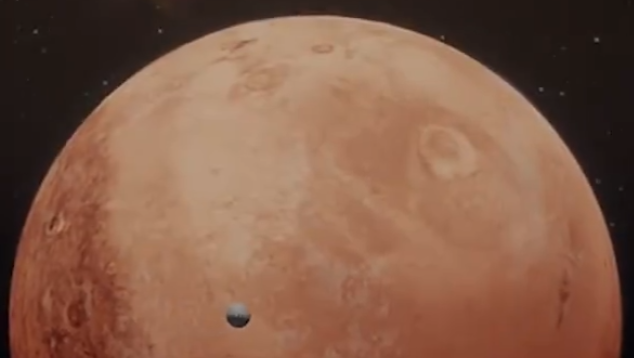Elon Musk’s dream of colonizing Mars draws one step closer as technology continues to advance.
Researchers have made a groundbreaking discovery on Mars, detecting water frost on the Tharsis volcanoes, which are among the highest in the solar system and located near the Martian equator. This finding challenges longstanding assumptions about the Martian climate and offers new insights into the planet’s environmental conditions.
Big Breaking: Frost discovered on Mars suggests a dynamic water cycle. On the Tharsis volcanoes. This area includes Olympus Mons, the tallest volcano in the solar system.
The Tharsis volcanoes are located near the equator of Mars.
pic.twitter.com/5vHDabI7pq— Union Public Service Commentary (UPSC) (@upsc_unofficial) June 10, 2024
Led by Adomas Valantinas, a postdoctoral fellow at Brown University and former Ph.D. student at the University of Bern, the team published their study in “Nature Geoscience.” They reported the first observation of frost near Mars’ equator, where the combination of sunshine and thin atmosphere typically results in higher temperatures, making frost formation unlikely. This phenomenon suggests remnants of an ancient climate cycle, possibly involving precipitation and even snowfall on these volcanic regions.
#Water frost has been discovered on Mars near the Red Planet’s equator.
Olympus Mons, the highest volcano in the solar system. New research has revealed water frost at the Martian equator for the first time. The best discovery since 2016.#BreakingNews#nasa #Mars #space #life pic.twitter.com/2ROzyx9OWu— PxPx2025 (@PxPx2025) June 10, 2024
The frost, though incredibly thin—about one-hundredth of a millimeter, roughly the width of a human hair—is extensive. It appears only for a few hours after sunrise before evaporating. Despite its thinness, it represents a significant amount of water, estimated at 150,000 tons daily during the cold seasons, equivalent to the volume of approximately 60 Olympic-size swimming pools.
Tharsis hosts multiple towering volcanoes, including Olympus Mons, which is as wide as France. The frost forms in the calderas at the summits of these volcanoes. These calderas are large hollows created by past volcanic eruptions. The researchers suggest that unique air circulation patterns over these mountains create microclimates that support the formation of these thin patches of frost.
In a significant first, researchers detect water frost on solar system’s tallest volcanoes | Brown University https://t.co/wKyy0Y0sVx
— Javelina Blue (@JavelinaBlue) June 11, 2024
The team utilized high-resolution color images from the Colour and Stereo Surface Imaging System (CaSSIS) aboard the European Space Agency’s Trace Gas Orbiter to detect the frost. Their findings were corroborated by data from the High Resolution Stereo Camera on ESA’s Mars Express orbiter and the Nadir and Occultation for Mars Discovery spectrometer on the Trace Gas Orbiter. Analyzing over 30,000 images, Valantinas refined the search based on location, time of day, and season, isolating the spectral signatures indicative of water frost and pinpointing where on Mars it formed.
Valantinas began his work on this project in 2018, and while much of the analysis was conducted during his Ph.D. program, he has continued this research at Brown University. Now working in the laboratory of planetary scientist Jack Mustard, Valantinas is shifting his focus towards astrobiology. He aims to characterize ancient hydrothermal environments on Mars that may have supported microbial life. These studies are part of broader efforts that could contribute to future missions, such as the NASA-led Mars Sample Return mission, potentially bringing back samples from these environments to Earth.
This discovery not only deepens our understanding of Martian atmospheric dynamics but also enhances our knowledge of where water exists on Mars and how it behaves, which is crucial for future exploration and the search for signs of life. Valantinas’s work underscores the ongoing fascination and potential for discovering a “second genesis” of life beyond Earth.
Key Points :
i. Researchers discovered water frost on the Tharsis volcanoes on Mars, challenging previous understandings of the Martian climate.
ii. The frost, found near the equator, suggests possible remnants of an ancient climate cycle with conditions allowing for precipitation and maybe snowfall.
iii. Despite being only about one-hundredth of a millimeter thick, the frost represents a significant daily exchange of water, approximately equivalent to 60 Olympic-sized swimming pools.
iv. The findings were based on over 30,000 images analyzed from several instruments aboard the European Space Agency’s Trace Gas Orbiter and Mars Express orbiter.
v. This discovery has implications for understanding Martian atmospheric dynamics, the hydrological cycle, and could inform future exploration and the search for life on Mars.
James Kravitz – Reprinted with permission of Whatfinger News



